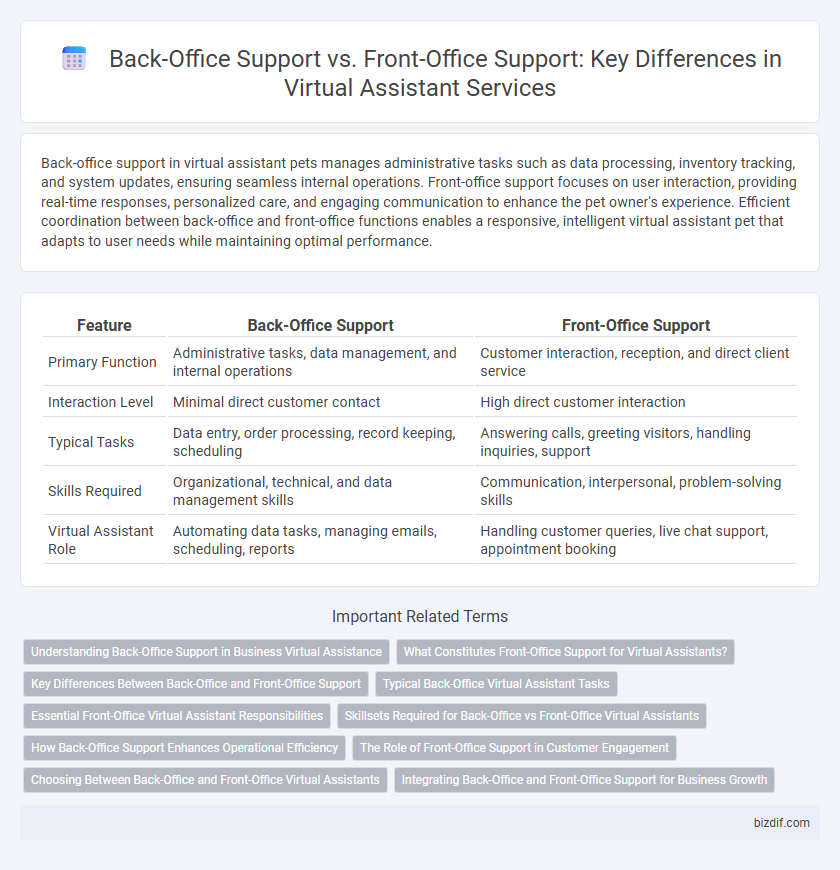Back-office support in virtual assistant pets manages administrative tasks such as data processing, inventory tracking, and system updates, ensuring seamless internal operations. Front-office support focuses on user interaction, providing real-time responses, personalized care, and engaging communication to enhance the pet owner's experience. Efficient coordination between back-office and front-office functions enables a responsive, intelligent virtual assistant pet that adapts to user needs while maintaining optimal performance.
Table of Comparison
| Feature | Back-Office Support | Front-Office Support |
|---|---|---|
| Primary Function | Administrative tasks, data management, and internal operations | Customer interaction, reception, and direct client service |
| Interaction Level | Minimal direct customer contact | High direct customer interaction |
| Typical Tasks | Data entry, order processing, record keeping, scheduling | Answering calls, greeting visitors, handling inquiries, support |
| Skills Required | Organizational, technical, and data management skills | Communication, interpersonal, problem-solving skills |
| Virtual Assistant Role | Automating data tasks, managing emails, scheduling, reports | Handling customer queries, live chat support, appointment booking |
Understanding Back-Office Support in Business Virtual Assistance
Back-office support in business virtual assistance involves managing internal tasks such as data entry, accounting, inventory management, and administrative duties that ensure smooth operational workflows. Unlike front-office support, which deals directly with customer interaction and client-facing activities, back-office support maintains the essential behind-the-scenes functions critical to business efficiency and accuracy. Virtual assistants specializing in back-office support help businesses reduce operational costs and improve data organization by handling tasks that do not require direct customer engagement.
What Constitutes Front-Office Support for Virtual Assistants?
Front-office support for virtual assistants encompasses tasks involving direct interaction with customers, such as answering inquiries, managing appointments, and handling communications through phone, email, or chat platforms. It requires strong communication skills, customer service expertise, and real-time problem-solving abilities to enhance client satisfaction. Key responsibilities include live chat support, appointment scheduling, and managing social media engagement to maintain positive client relationships.
Key Differences Between Back-Office and Front-Office Support
Back-office support primarily handles administrative tasks such as data entry, payroll, and record management, ensuring smooth internal operations without direct customer interaction. Front-office support focuses on customer-facing activities including sales, inquiries, and service, playing a crucial role in customer satisfaction and brand representation. The key difference lies in back-office support optimizing internal processes, while front-office support drives customer engagement and business growth.
Typical Back-Office Virtual Assistant Tasks
Typical back-office virtual assistant tasks include data entry, managing databases, processing invoices, and handling payroll. These assistants also provide support by organizing files, managing inventory records, and performing routine administrative duties that do not involve direct customer interaction. Their role ensures seamless internal operations, allowing front-office teams to focus on customer service and engagement.
Essential Front-Office Virtual Assistant Responsibilities
Essential front-office virtual assistant responsibilities include managing incoming communications, scheduling appointments, and providing real-time customer service to enhance client interactions. These tasks demand proficiency in communication tools, calendar management software, and CRM systems to maintain seamless workflows. Unlike back-office support, which focuses on administrative tasks such as data entry and record keeping, front-office support directly influences customer satisfaction and brand reputation.
Skillsets Required for Back-Office vs Front-Office Virtual Assistants
Back-office virtual assistants require strong skills in data entry, database management, and proficiency with software like Excel, CRM systems, and accounting tools to efficiently handle administrative tasks behind the scenes. Front-office virtual assistants must excel in communication, customer service, appointment scheduling, and multitasking while using tools such as video conferencing software, email platforms, and customer relationship management to interact directly with clients. Both roles demand organizational skills and time management, but front-office assistants prioritize interpersonal abilities whereas back-office assistants focus on technical and analytical competencies.
How Back-Office Support Enhances Operational Efficiency
Back-office support streamlines administrative, data management, and record-keeping tasks, enabling front-office teams to focus on customer interactions and sales. Automating processes like invoice processing, payroll, and inventory management reduces errors and accelerates workflow, directly improving operational efficiency. This division of labor ensures seamless business operations and enhances overall productivity by minimizing bottlenecks in back-office functions.
The Role of Front-Office Support in Customer Engagement
Front-office support plays a crucial role in customer engagement by directly interacting with clients through channels like phone, email, and live chat, ensuring immediate issue resolution and personalized service. This front-line interaction helps gather valuable customer feedback, drive satisfaction, and build long-term loyalty. Unlike back-office support, which handles internal processes and data management, front-office support shapes the customer experience and first impressions.
Choosing Between Back-Office and Front-Office Virtual Assistants
Choosing between back-office and front-office virtual assistants depends on business needs and operational focus. Back-office VAs excel in administrative, data management, and technical tasks, boosting efficiency without direct client interaction. Front-office virtual assistants specialize in customer service, appointment scheduling, and communication, enhancing client engagement and satisfaction.
Integrating Back-Office and Front-Office Support for Business Growth
Integrating back-office support, including data management and administrative tasks, with front-office support such as customer service and sales interactions enhances operational efficiency and customer satisfaction. Streamlined communication between these functions enables faster issue resolution and personalized service delivery, driving business growth. Leveraging virtual assistants to synchronize workflows ensures seamless collaboration and optimized resource allocation across both support areas.
Back-office support vs Front-office support Infographic

 bizdif.com
bizdif.com